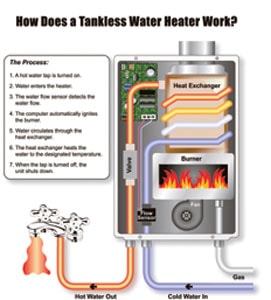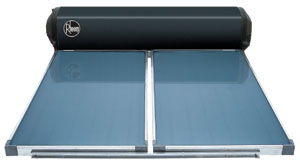Based on sky-rocketing energy costs, selecting household appliances such as water heaters can be a balancing act. On one hand, homeowners want comfort and performance, and on the other they want cost-saving efficiency. And, when accommodating luxury items such as his-and-her showers, garden bathtubs or spas, the decision gets increasingly complicated. In this article, Extreme How-To turns to the experts to shed some light on the latest water-heating technology.
“Because residential products are changing at an extraordinary pace due to technology advancements, it is critical that consumers know what’s available,” says Hank Darlington, a kitchen and bath consultant who advises interior design professionals. “For example, one of the newest products available is tankless water heaters, which are truly green and more energy-efficient than conventional tank heaters since the need to maintain a heated water supply is eliminated.“
So here’s a look at what’s new in the world of hot water, from tanks to tankless to solar-powered systems.
Tanks Very Much
A household standard for many years, tank-style water heaters provide a large volume of dependable hot water. Fuel sources include propane, natural gas or electricity, and these units are the most common way to heat water in the United States. A typical residential tank water heater stores between 20 and 80 gallons, heating the water 24/7, usually at the factory setting of 120 degrees F. However, there is only so much room in the water tank, so if demand is high or the unit isn’t sized correctly, the hot water can run out. The large size of a tank unit is another aspect to consider. Because of their bulk, tank water heaters are typically located in the garage or basement, but this can put the hot water source far from the point of use. When homeowners complain that it takes too long for the hot water to reach the bathroom, this is usually the reason.
Like any major appliance, the tank heaters should be carefully matched to the demands of the house. According to the experts at Rheem, upgrading a standard 5-by-9-foot bathroom to a master suite or an in-home spa may require upgrading to a larger unit, especially if the new bathroom will include a deep soaking tub with a multi-head shower system. However, if this is the case, replacing a tank water heater with another tank water heater is fast and keeps labor costs to a minimum. If a remodeling budget is tight, tank water heaters are the most affordable choice, because of the minimal labor required. The cost of professional installation is typically between $500 and $1,000.
It should be reiterated that tank units also heat water even when not in use. Insulation between the storage tank and the outer jacket reduces the heat loss, but cannot entirely eliminate it. To maintain a preset water temperature, the water heater must cycle on periodically, even when there is no demand for hot water.

No Tanks
Over the past few years, a popular topic among home-improvement enthusiasts is the advent of tankless water heaters manufactured by companies such as Rheem, Takagi, Rinnai, Noritz and Bosch. Unlike tank-style heaters, tankless gas water heaters are more energy-efficient than conventional because they eliminate the need to continually heat a large supply of water. Also called on-demand water heaters, water enters the gas or electric tankless water heater only when the hot water valve is opened, which then triggers the heating coils or heat exchanger. The amount of energy consumed is proportional to the volume of hot water used. This energy-saving advantage is what makes tankless units today’s most popular “green” hot water solution. Furthermore, no matter how many showerheads, and no matter how deep the whirlpool, homeowners will not run out of hot water if using a properly sized tankless water heater.

Image courtesy of Takagi
The compact size of tankless unit is another benefit. The bulk of the tank-style units lies with the tank itself; so no tank, no bulk. About the size of a medicine cabinet, tankless water heaters can easily be wall-mounted indoors or outdoors, depending on the climate. This affords the ability to place a tankless water heater closer to the point of use, which solves the problem of a long wait for hot water. Although, the “long wait” problem is not solved by simply replacing a tank heater with a tankless heater in the same spot. Delays in hot water delivery have to do with the proximity of the water heater, not the type of water heater.

As far as installation, the experts at Rheem explain that new construction is a breeze with tankless water heaters, and installation costs are comparable to those of a tank-type unit. But replacing a tank water heater in an existing home with an indoor tankless hot water heater takes a few extra steps, depending on the water heater’s location and the piping layout. Because tankless heaters use more powerful burners than their tank-style counterparts, they require larger gas lines. And, indoor tankless water heaters must be vented vertically (through the roof) or horizontally (through the walls). Tankless water heaters have a higher installation cost than tank water heaters, but lower operating costs, less waste and superior hot water delivery. Get a few different quotes for labor, because the installation cost can vary dramatically from contractor to contractor, due in large part to the different approaches they may take when deciding where to locate the heating unit.
Solar Heated Water
Solar water heaters use a dark-color solar collector to capture energy from the sun, making it the “greenest” home water heating option available. These solar systems can be “passive,” meaning the water flows between the collection area to the storage tank via gravity or some other non-mechanical means; or “active,” which uses a pump to circulate water through the system. The passive systems have both the tank and collector located on the roof, taking full advantage of the direct sunlight. However, some roofs aren’t designed to support the weight of the water tank (and some homeowner associations may frown on a roof-mounted tank), and an active system is the alternative. The active systems have the tank and pump located in the house or garage, but the pump that forces circulation does require more energy than passive systems.
Even the most efficient solar water heaters usually require some auxiliary heating to boost the performance. This may be because of a high water demand in the evening or after a long period of cloud cover. An electric, gas or other fuel-type booster can be quite effective in enabling a solar water heater to provide a year-round supply of steaming hot water, but of course that also boosts energy demands.

Rheem offers the latest advancement in solar water heating systems under the Rheem Solaraide brand. Combining a storage tank with one or two collector panels, these passive systems operate without pumps or controllers, relying instead on the natural process of convection to circulate the heat-transfer fluid.
Rheem Solaraide systems use a specially developed, freeze-proof fluid to absorb and deliver heat energy even on cold and overcast days. The fluid circulates through 35 multi-flow risers in the solar collector, soaking up the sun’s energy. Typically installed on a rooftop, the collector is coated with a black polyester powder-coat paint to maximize heat absorption. The heated fluid then moves to an attached storage tank that sits above the collector, which keeps the fluid circulating. Heat is then transferred quickly and efficiently to the potable water inside the tank. Pressure-injected polyurethane foam insulation keeps the water in the tank warm. At night or on heavily overcast days, an optional immersed copper-sheath backup element automatically activates to meet hot-water demand 24/7.
“These systems are comparatively straightforward to install, taking perhaps a day the first time—and probably less thereafter as the installer gains experience,” says Jeff Mahoney, Rheem alternative energy market manager. “To mount the system on the roof, all the installer needs is a pipe wrench, a crescent wrench, a hammer, screwdriver and drill.”
Rheem Solaraide water heaters are offered in two configurations, each carrying a five-year warranty: The 47-Gallon system, measuring 97-1/2 inches long and 58-1/2 inches wide, includes a single collector panel and provides the annual hot water requirements of a home with 1-1/2 baths. The 80-gallon system, measuring 97-1/2 inches long and 91 inches wide, uses two collector panels to meet the hot-water requirements of a home with two or three bathrooms.
Boiling it Down
As you can see, there are pros and cons to each type of water-heating system. The more efficient tankless systems have a greater upfront cost, but can pay off in energy savings and performance down the line. A replacement tank heater is less costly to install but requires more energy usage. And even the greenest of options—solar heating— requires some cooperation from Mother Nature to wring the most energy efficiency and performance from the system. So the next time you’re selecting a system, carefully weigh your initial installation budget against your long-term utility costs. And always keep up on the latest technology, because water heating is an ever-evolving industry.
Editor’s Note: Special thanks to Rheem Water Heating for the information provided in this article. For more information, visit www.smarterhotwater.com



